Highlights of Economic Survey 2023
2023-02-06 | Yadvendra Singh
Finance Minister Nirmala Sitharaman has tabled the pre-budget document i.e. Economic Survey 2022-23 on 31 January 2023 in Parliament. The survey has projected a baseline GDP growth of 6.5% in real terms in FY24. The projection is comparable to the estimates given by organisations like World Bank, IMF, ADB and RBI.

This year, again the survey has been released in a single volume and there is a separate volume for the Statistical Appendix.
President Droupadi Murmu for the first time addressed the joint session of the Parliament. The Budget Session of Parliament starts with the address of the President. After which, the economic survey is tabled.
What is Economic Survey? Who prepares Economic Survey?
Economic Survey is a detailed report of the state of the economy in the closing financial year. It is released by Chief Economic Advisor (CEA) and is prepared by the economic division of Department of Economic Affairs under the guidance of the CEA. The survey is approved by the Finance Minister.
The first economic survey was presented for 1950-51 and until 1964, it was presented along with the budget.
Between 2010-11 and 2020-21, the survey was presented in two volumes but again in 2021-22, the survey was presented in single volume format. The survey is presented one day before the budget i.e. on 31 January.
Economic Survey 2022-23 Highlights
1. Economic growth
The growth is expected to rise in FY24 as debt disbursal and capital investment are expected to start in India with strengthening of corporate and banking sectors’ balance sheets. The expansion of public digital platforms and initiatives like PM Gati Shakti, National Logistics Policy, PLI scheme to boost manufacturing output will further support economic growth.
In real terms, the economy is expected to grow at 7% for FY23.
Although there have been three shock waves of COVID-19, Russia-Ukraine conflict, Central banks increased policy rates to curb inflation, appreciation of dollar, widening of Current Account Deficit in net importing economies, yet, major global agencies have continued to project India as the fastest growing economy at 6.5-7% in FY23.
As per the survey, private consumption and capital formation have mainly contributed to India’s economic growth in FY23. They have helped in employment generation. This is seen in declining unemployment rate in urban areas and in the faster net registration in Employee Provident Fund. Private consumption in H1 is highest since FY15.
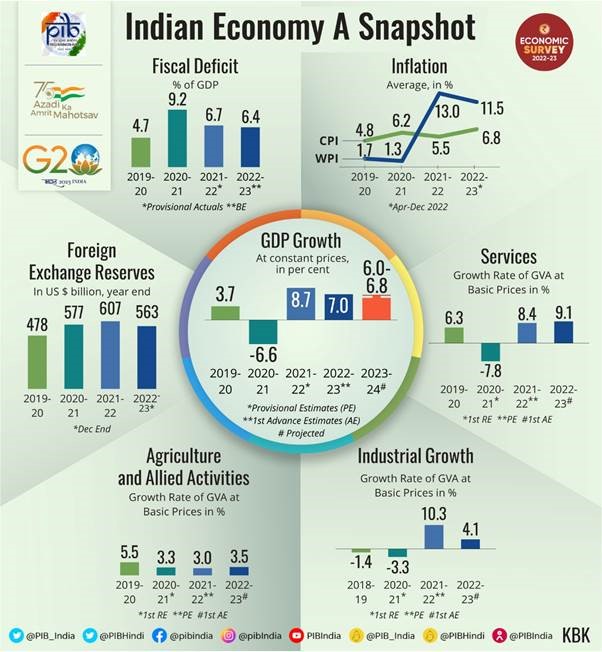
(Source: PIB)
The credit growth to the Micro, Small, and Medium Enterprises (MSME) sector was more than 30.6% on average during January-November 2022.
2. Fiscal Developments
A YoY growth of 15.5% from April to November 2022 has been registered in the Gross Tax Revenue.
The gross GST collections increased at 24.8% on YoY basis from April to December 2022.
Central government’s Capital Expenditure (Capex) increased by 63.4% in the first eight months of FY23.
Central government’s capex has steadily risen from a long-term average of 1.7% of GDP (FY09 to FY 20) to 2.5% of GDP in FY22 PA (Provisional Actual).
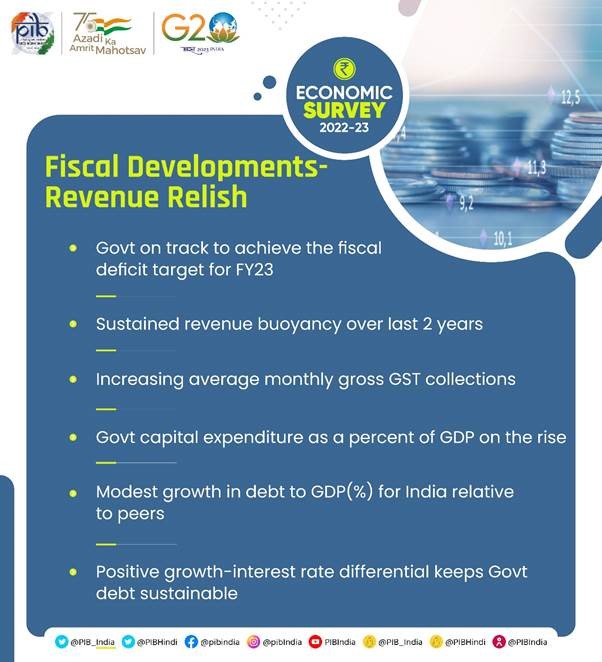
(Source: PIB)
3. Monetary Management and Financial Intermediation
RBI started its monetary tightening cycle in April 2022. It has since raised the repo rate by 225 bps.
Non-food credit offtake by SCBs has been rising in double digits since April 2022.
The Gross Non-Performing Assets (GNPA) ratio of scheduled Commercial Banks (SCBs) has declined to a seven-year low of 5.0. The Capital-to-Risk Weighted Assets Ratio (CRAR) is healthy at 16.0.
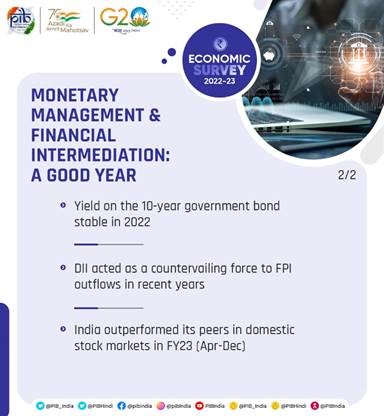
(Source: PIB)
4. Prices and Inflation
India’s retail inflation rate peaked at 7.8% in April 2022. Government took many steps to control the increase in price levels.
- Export duty of petrol and diesel was reduced in phase-wise manner.
- Government reduced import duty on major inputs to zero. It increased the tax on export of iron ores and concentrates from 30% to 50%.
- Government waived customs duty on cotton imports with effect from 14 April 2022, until 30 September 2022.
- It prohibited the export of wheat products under HS Code 1101. It imposed an export duty on rice.
- Basic duty on crude and refined palm oil, crude soyabean oil and crude sunflower oil was reduced.
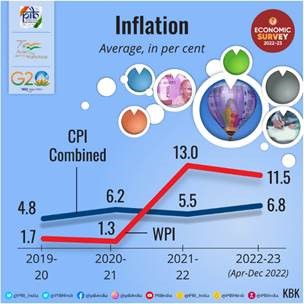
(Source: PIB)
5. Social Infrastructure and Employment
Central and State Government’s budgeted expenditure on health sector reached 2.1% of GDP in FY23 (Budget Estimate) and 2.2% in FY22 (Revised Estimate) against 1.6% in FY21.
Social sector expenditure increased from Rs. 9.1 lakh crore in FY16 to Rs. 21.3 lakh crore in FY23 (BE).
In the Economic Survey, the findings of the 2022 report of the UNDP on the Multidimensional Poverty Index have been highlighted. The report says that 41.5 crore people came out of poverty in India between 2005-06 and 2019-20.
The survey says that labour markets have recovered beyond pre-Covid levels, in both urban and rural areas.
According to the survey, the year FY22 saw improvement in Gross Enrolment Ratios (GER) in schools.
Out-of-pocket expenditure as a percentage of total health expenditure has decreased from 64.2% in FY14 to 48.2% in FY19.
A steady decline has been seen in Infant Mortality Rate (IMR), Under Five mortality rate (U5MR) and neonatal Mortality Rate (NMR).
Over 220 crore COVID vaccine doses administered as on 06 January 2023.
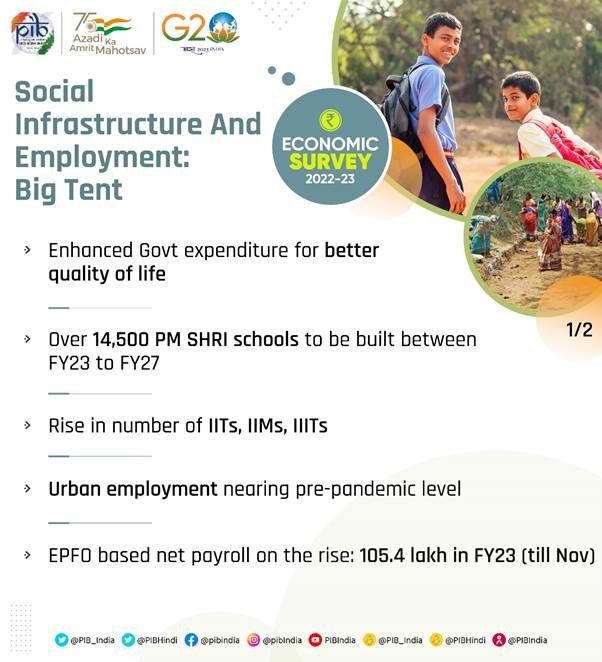
(Source: PIB)
6. Climate Change and Environment
India declared its net zero emissions goal by 2070. It achieved its target of 40% installed electric capacity from non-fossil fuels ahead of 2030. India will reduce emissions intensity of its GDP by 45% by 2030 from 2005 levels. Sovereign Green Bond Framework (SGrBs) launched in November 2022. Two tranches of ₹4,000 crore Sovereign Green Bonds (SGrB) were auctioned by RBI. National Green Hydrogen Mission to enable India to be energy independent by 2047. The Survey highlights the progress on eight missions under the National Action Plan on Climate Change.
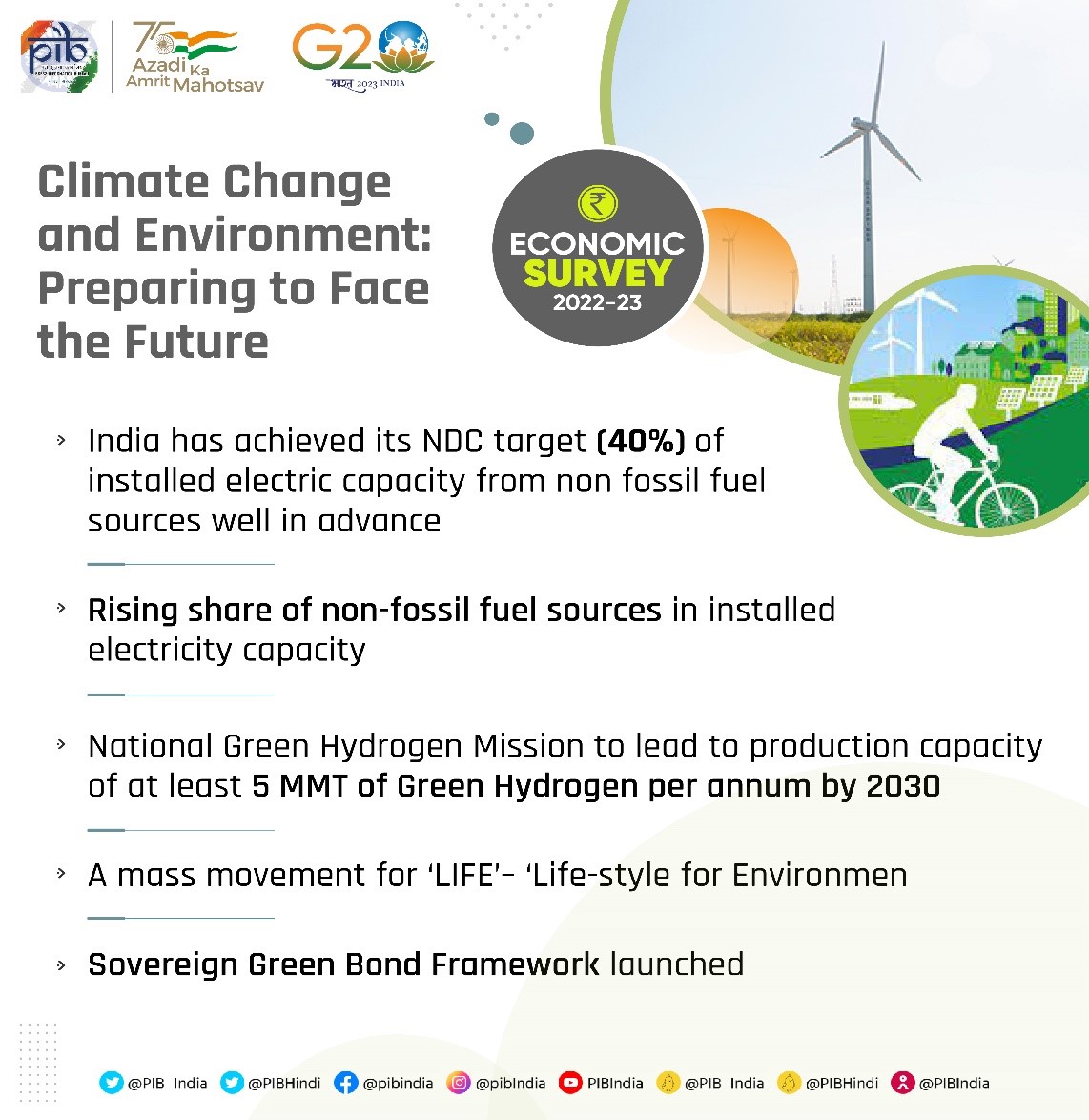
(Source: PIB)
7. Agriculture and Food Management
Private investment in agriculture has risen to 9.3% in 2020-21.
Free foodgrains to about 81.4 crore beneficiaries under the National Food Security Act for one year from January 1, 2023.
Organic Farming is being promoted through Farmer Producer Organisations (FPO) under the Paramparagat Krishi Vikas Yojana (PKVY).
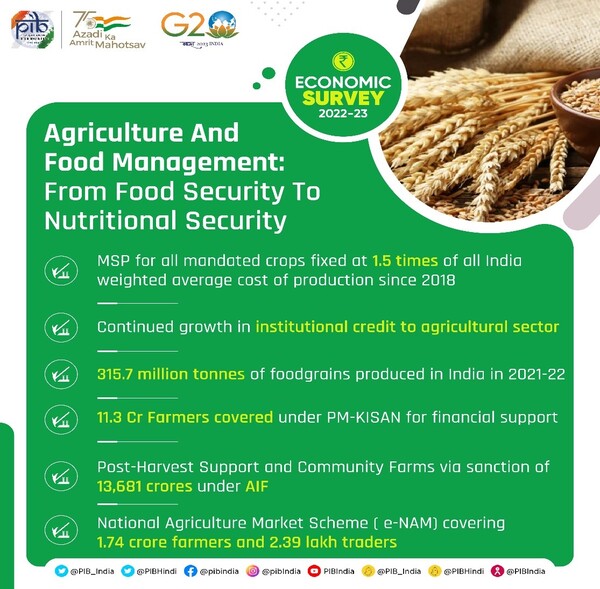
(Source: PIB)
8. Industry
Overall Gross Value Added (GVA) by the Industrial Sector (for the first half of FY 22-23) rose 3.7%. This is higher than the average growth of 2.8% achieved in the first half of the last decade.
PMI manufacturing has remained in the expansion zone for 18 months since July 2021.
Credit to MSMEs has increased by an average of around 30% since January 2022.
Credit to large industry has been showing double-digit growth since October 2022.
Electronics exports rise nearly threefold to US $11.6 Billion in FY22.
India has become the second-largest mobile phone manufacturer globally.
FDI flows into the Pharma Industry have risen four times during FY19 to FY22.
Exports of goods and services as a share of GDP have been the highest since FY16 in H1 of FY 22-23.
9. Services
It is expected that the services sector will grow at 9.1% in FY23 in comparison to 8.4% (YoY) in FY22.
Robust expansion in PMI services observed since July 2022. India was among the top ten services exporting countries in 2021.
Credit to services sector has increased by more than 16% since July 2022.
75 Digital Banking Units announced for transforming financial services.
Fashion, grocery and general merchandise will capture nearly two-thirds of the Indian e-commerce market by 2027.
It is projected that India’s e-commerce market will grow at 18% annually through 2025.
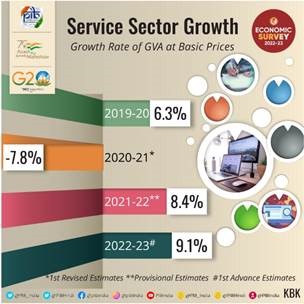
(Source: PIB)
10. External Sector
Merchandise exports stood at US$ 332.8 billion for April-December 2022.
In 2022, Comprehensive Economic Partnership Agreement (CEPA) with UAE and Economic Cooperation and Trade Agreement (ECTA) with Australia come into force.
India is the largest recipient of remittances in the world. It received US$ 100 bn in 2022.
Remittances are the second largest major source of external financing after service export. India is 7th largest service exporter in the world.
As of December 2022, Forex Reserves stood at US$ 563 bn.
India is the sixth largest foreign exchange reserves holder in the world as of end-November 2022.

(Source: PIB)
11. Physical and Digital Infrastructure
a. Physical Infrastructure
India Infrastructure Project Development Fund (IIPDF) Scheme was notified by the government on 3 November 2022 with ₹150 crore outlay from FY 23-25.
National Infrastructure Pipeline (NIP) and Project Monitoring Group (PMG) portal linkage to fast-track approvals/ clearances for projects.
The National Monetisation Pipeline (NMP) was announced on 23 August 2021. ₹ 0.9 lakh crore monetisation target achieved against expected ₹0.8 lakh crore in FY22. FY23 target is envisaged to be ₹1.6 lakh crore (27% of overall NMP Target).
The government has permitted the entire target capacity of 40 GW for the development of 59 Solar Parks in 16 states as on 30 September 2022.
Rapid increase in National Highways (NHs) /Roads Construction. 10457 km NHs/roads constructed in FY22 compared to 6061 km in FY16.
Over one crore air passengers availed the benefit of the UDAN scheme since its start in 2016.
The capacity of major ports has nearly doubled in 8 years from March 2014 to March 2022.
b. Digital public infrastructure
Unified Payment Interface (UPI)-based transactions grew in value (121%) and volume (115%) terms, between 2019-22.
As of September 2022, the total telephone subscriber base in India stands at 117.8 crore, with 44.3% of subscribers in rural India.
Over 98% of total telephone subscribers are connected wirelessly and in March 22, overall tele-density in India stood at 84.8%.
200% increase has been recorded in rural internet subscriptions between 2015 and 2021.
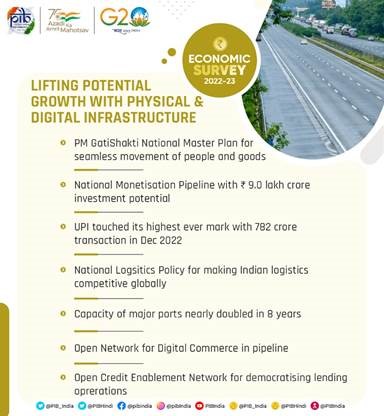
(Source: PIB)
Frequently Asked Questions (FAQs) about Economic Survey 2022-23
Who presented Economic Survey 2023?
What is the expected growth rate for the year ending March 2023 as per Economic Survey 2022-23?
Is economic survey released every year?
Who prepares Economic Survey?
Share Blog







Comments